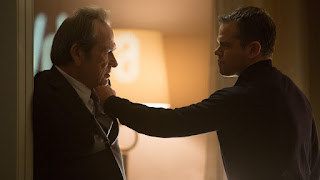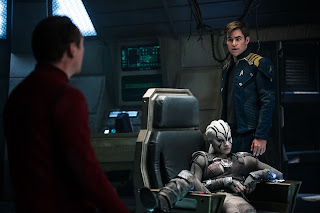EPIC FAIL
Film Review by Fiore
 The troubles that plagued the previous Jason Bourne films,
also hinder this latest endeavor from Director and Screenwriter Paul
Greengrass, except this time, all of those cinematic ills are on steroids.
The troubles that plagued the previous Jason Bourne films,
also hinder this latest endeavor from Director and Screenwriter Paul
Greengrass, except this time, all of those cinematic ills are on steroids.
When critiquing Greengrass’ films, there are always two
views to consider. First, there is his
typical modus operadi, which includes horrible cinematography and editing; and
there is his blatant political pontifications, which align themselves with the
insipid ideology of the UK Guardian.
Let’s talk politics first.
The overriding theme in JASON BOURNE is the concept of one’s
privacy rights vs. the preservation of freedom.
This is a key component of our society for many purport you can’t have
one without the other. (That simply is
not true. You can have both
simultaneously, but it involves elements not deemed politically correct to
accomplish.) Greengrass is an
ultra-liberal Brit, still angry the Colonies broke away. As such, he is totally against anything
America does that does not fit in with others of his ilk. Therefore, the bad guys in JASON
BOURNE are the same antagonists as in all his Bourne endeavors – the
American government, and more specifically, the CIA.
Let’s take a little walk down the political road Greengrass
paves for us in this film.
According to
the themes in his script: no one should ever do anything to preserve freedom
that would hinder one’s privacy; the recent onslaught of lone wolf terrorist
attackers is simply a ploy used by America’s intelligence agencies to cover
their own dirty deeds and turning public sentiment against peaceful Muslims;
and the American Government, through its intelligence agencies, wants to spy on
every individual, all the time. This
final political concept is very popular in movies today; however, Christian
Bale as Batman, and Morgan Freeman as Lucius Fox covered the concept with
better aplomb in THE DARK KNIGHT.
If you are comfortable being lectured about these issues by
an Englishman, in the guise of an action film, then you may find some merit in JASON
BOURNE. Personally, I don’t
agree with Greengrass’ vision of the perfect world (a phrase he uses for his
production company – Perfect World Pictures) and his constant attempts to
promote an America more in the vain of an idyllic England, are nauseating. He finds a compatriot soul in Matt Damon, who
is also one of the Blame-America-First members in Tinseltown.
Now that politics are covered, let’s take a gander at the
filmmaking elements of JASON BOURNE.
This film is an absolute nightmare to watch. Greengrass combines with Cinematographer
Barry Ackroyd and Editor Christopher Rouse to create a hodgepodge of nonsensical
visual elements. Allow me to return to
my teaching days, and be just a bit technical.
The film’s action sequences consistently cross the 180-degree
line. In addition, when the cross is
made, the shot is slightly out of focus and then quickly adjusts. Ackroyd uses, almost exclusively, tight
close-up shots, which totally ruin all the fine work by Fight Choreographer
Roger Yuan. Yuan knows how to stage
fight scenes. He has worked on BLADE,
with Wesley Snipes; SPAWN, with Michael Jai White; and on this year’s WARCRAFT,
which is one of the year’s better films.
 In addition, Simon Crane serves as Second Unit Director,
and he is known throughout the industry for his stunt work and fight
choreography. The combination of Yuan
and Crane should be dynamic. Not content with ruining their work, Ackroyd then
incorporates WWE zooms on the action. Rouse
then takes the close-up shots and quick cuts all of them. The results are action sequences that flash
and blur, like a child’s cartoon, but cannot be deciphered in any aspect of
reality.
In addition, Simon Crane serves as Second Unit Director,
and he is known throughout the industry for his stunt work and fight
choreography. The combination of Yuan
and Crane should be dynamic. Not content with ruining their work, Ackroyd then
incorporates WWE zooms on the action. Rouse
then takes the close-up shots and quick cuts all of them. The results are action sequences that flash
and blur, like a child’s cartoon, but cannot be deciphered in any aspect of
reality.
For establishing shots, Greengrass orchestrates just as
much mayhem. He utilizes the carefully structured look of Uncle Charlie’s
backyard cookout. The camera never stays
still, swerving without purpose from side to side or up and down. A tripod would help. The underlying purpose is understandable;
Greengrass wants to convey chaos to viewers.
Unfortunately, the end result is so dysfunctional the screen will
provide viewers with massive headaches before the final reels. It’s akin to a steady diet of J.J. Abrams’ CLOVERFIELD.
This has been Greengrass’ stratagem on all the Bourne
films, and one of the reasons is star Matt Damon can’t fight. He has a personal trainer who helps him
achieve a magnificent physique, but the build won’t help you when facing an
assailant. He is certainly no Snipes or
White. He isn’t even Jason Statham or
Mark Wahlberg. Perhaps he is better
served floating in space, waiting for a ride home, as he did in THE
MARTIAN.
Our story begins when Nicky Parsons, played by Julia
Stiles, one of Jason Bourne’s comrades, hacks into the CIA server and downloads
all of the agency’s black ops material.
Apparently she still couldn’t find Hillary Clinton’s 33,000 emails, but
that is, in the words of Conan, another tale. She contacts Bourne because the material
reveals even more secrets about his past.
Here, the script turns sour.
All through the Bourne series, Jason is trekking to
self-discovery. Batman and Spider-Man
didn’t go through this much angst. Greengrass demonstrates lack of creativity
in resorting to the same plot lines and same antagonists as the previous films. Any reader of the Robert Ludlum novels knows
there is more to the character than these one dimensional premises contain.
So, well into movie number three, Bourne is still trying to
discern new elements of his past. This
causes CIA Director Robert Dewey, played by Tommy Lee Jones, a bit of
consternation because he doesn’t want the black ops made public. He enlists two associates, Heather Lee, played
by Alicia Vikander and “The Asset” played by Vincent Cassel.
Jones has little more than a cameo role, in which he
displays all the manic foibles Greengrass wants associated with the CIA. Vikander, who burst on the cinematic scene in
EX
MACHINA, where she spent a majority of the film nude, offers a rather
mundane performance, which possibly could have been helped by her disrobing. (That
statement may be considered insensitive, but unfortunately it is also true.) Cassel is great. I do not recall ever seeing this man in a bad
performance. He holds the entire
mishmash together and is the only reason I didn’t walk out on this debacle.
KEY SCENES TO LOOK FOR:
1.
The end credits.
 There are several behind the scenes elements making JASON
BOURNE a little more interesting.
First, the trailers for the film show key scenes, but from camera angles
different than the ones used in the movie.
This is a very clever marketing ploy, though in some cases, the angle
used in the trailers is better.
There are several behind the scenes elements making JASON
BOURNE a little more interesting.
First, the trailers for the film show key scenes, but from camera angles
different than the ones used in the movie.
This is a very clever marketing ploy, though in some cases, the angle
used in the trailers is better.
Then there is Jeremy Renner. Damon announced he was done with the Bourne
character. Universal, however, realized
it was sitting on a gold mine with the character, and Ludlum had written many
more novels. Also, upon Ludlum’s death,
the novelization mantle was passed to Eric Van Lustbader who cranked out Bourne
novels like a Twix factory. The studio
brought in Renner and simply shifted the character to Aaron Cross, a bit of a
play on James Patterson’s character Alex Cross.
The Renner film scored well at the box office and it seemed he had
inherited the franchise.
When Universal announced Renner’s next go as Cross,
Greengrass and Damon announced they were coming out of retirement with Jason
Bourne. Initially, the films were
scheduled for a near simultaneous release.
Due to JASON BOURNE, the Aaron Cross film, though still planned, is
currently in a state of suspended animation.
Do you think Renner will invite Damon over at his next
get-together? Nah.
With the combination of anti-American sentiment, horrible cinematography
and editing, JASON BOURNE is a celluloid disaster. If you are a fan of the series, best wait for
this one to come to one of the streaming services. Then you won’t mind wasting your money.
THE
GRADE FOR JASON BOURNE = D.



